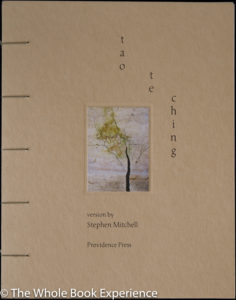 Like it should, the Tao Te Ching arrived exactly when I needed it. The Tao helped me get through a really rough patch of my life: a dissolving marriage, unbelievable animosity and accusations, and stressful negotiation of parental rights through a nasty family court process. Reading it over and over helped me get through that process with my dignity and without saying or doing anything I now regret or asking for anything that was above and beyond what was reasonable and best for my kids.
Like it should, the Tao Te Ching arrived exactly when I needed it. The Tao helped me get through a really rough patch of my life: a dissolving marriage, unbelievable animosity and accusations, and stressful negotiation of parental rights through a nasty family court process. Reading it over and over helped me get through that process with my dignity and without saying or doing anything I now regret or asking for anything that was above and beyond what was reasonable and best for my kids.
Do you have the patience to wait
till your mud settles and the water is clear?
Can you remain unmoving
till the right action arises by itself?
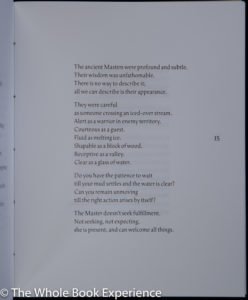 That’s Verse 15. I went back to it again and again. I didn’t get a fair parenting plan but the Tao helped me accept that too.
That’s Verse 15. I went back to it again and again. I didn’t get a fair parenting plan but the Tao helped me accept that too.
The edition I read back then was the Tao Te Ching: An Illustrated Journey, translated by Stephen Mitchell. Not only did it make me a Taoist but it sent me on a mission to see who Stephen Mitchell was and what else he had to say. Meaning I’ve since read his versions of the Bhagavad Gita, Rilke’s Letters to a Young Poet and The Lay of the Love and Death of Cornet Christoph Rilke (reviewed here), the Second Book of the Tao, and The Gospel According to Jesus. I enjoyed and admire all of this books.
One of the things I especially love about Mitchell’s translation is that it refuses to gender everything male. Mitchell states his position on gender in the foreword to the trade edition of this translation (not included in the Providence Press edition) as:
The reader will note that in the many passages where Lao Tzu describes the Master, I have used the pronoun “she” at least as often as “he.” The Chinese language doesn’t make this kind of distinction; in English we have to choose. But since we are all, potentially, the Master (since the Master is, essentially, us), I felt it would be untrue to present a male archetype, as other versions have, ironically, done. Ironically, because of all the great world religions the teaching of Lao Tzu is by far the most female. Of course, you should feel free, throughout the book, to substitute “he for “she” or vice versa.
Since my first contacts with the Tao I’ve delved deeply into the Yoga Sutra of Patañjali and see a lot of parallels with my yoga and the Tao.
Weapons are the tools of violence:
all decent men detest them.Weapons are the tools of fear;
a decent man will avoid them
except in the direst necessity
and, if compelled, will use them
only with the utmost restraint.
Peace is his highest value.
If the peace has been shattered,
how can he be content?
His enemies are not demons,
but human beings like himself.
He doesn’t wish them personal harm.
Nor does he rejoice in victory.
How could he rejoice in victory
and delight in the slaughter of men?He enters a battle gravely,
with sorrow and with great compassion,
as if he were attending a funeral.
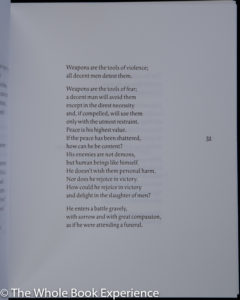 That’s verse 31 and very reminiscent of the Bhagavad Gita and possibly a realistic way to look at the world and the perceived “necessity” of force. Krishna might say this same thing to Arjuna. But it’s even a bit too much for someone who has taken the great vow of yoga and ahimsa, or non-harm.
That’s verse 31 and very reminiscent of the Bhagavad Gita and possibly a realistic way to look at the world and the perceived “necessity” of force. Krishna might say this same thing to Arjuna. But it’s even a bit too much for someone who has taken the great vow of yoga and ahimsa, or non-harm.
The Tao has great lessons to teach our politicians and citizens in an increasingly nationalistic world as well:
A great nation is like a great man:
When he makes a mistake, he realizes it.
Having realized it, he admits it.
Having admitted it, he corrects it.
He considers those who point out his faults
as his most benevolent teachers.
He thinks of his enemy
as the shadow that he himself casts.If a nation is centered in the Tao,
if it nourishes its own people
and doesn’t meddle in the affairs of others,
it will be a light to all nations in the world.
I could go on and on with the passages I’ve highlighted in the six different editions I own. But I think I’ll leave it at that for now and talk about this edition specifically.
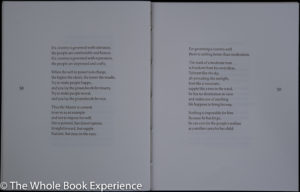 You can imagine how excited I was to see a private press edition of the Tao. Any edition would be on my wish list but a version of Stephen Mitchell’s text made it that much more exciting for me. I was a bit blindsided by it, to tell the truth, with Norman Clayton reaching out to me to let me know that his Providence Press had just published it. Not only that but I had somehow missed it at CODEX, which just goes to show you I need to give myself more time to walk the tables there. Norman had remembered me mentioning my admiration for Stephen Mitchell’s Tao in one of the posts here (probably the Arion Press Rilke?) and that I would love to see a private press edition. And viola, he reached out!
You can imagine how excited I was to see a private press edition of the Tao. Any edition would be on my wish list but a version of Stephen Mitchell’s text made it that much more exciting for me. I was a bit blindsided by it, to tell the truth, with Norman Clayton reaching out to me to let me know that his Providence Press had just published it. Not only that but I had somehow missed it at CODEX, which just goes to show you I need to give myself more time to walk the tables there. Norman had remembered me mentioning my admiration for Stephen Mitchell’s Tao in one of the posts here (probably the Arion Press Rilke?) and that I would love to see a private press edition. And viola, he reached out!
Providence Press is the book imprint of Norman’s Classic Letterpress, which designs and prints for individuals and organizations, including a recent book for the Book Club of California. The stated mission of Providence Press is to “produce books as beautiful as the writing is wise.” While Clayton had already been considering the Tao Te Ching as his first book under the imprint, when Norman moved to Ojai California he learned that Stephen Mitchell lived there, having moved there years previously also from the Bay Area. After contacting Mitchell, and with his generous encouragement, this edition was born. A nice little bit of bookish serendipity,
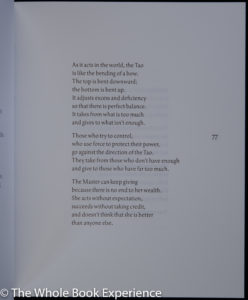 The Providence Press edition as designed and printed by Norman is simple, understated, and elegant. Like the Tao. The sole illustration, a photograph by Norman’s mother Burneta Clayton, is on the front cover. The Tao is presented here just as verse; no commentary or notes or other distractions. Each verse is beautifully placed on the page with crisp typography using the Davanti typeface. I really applaud the choice of a Coptic binding done by Molly Dedmond as this type of binding was used in early (Christian) spiritual texts, and thus has spiritual roots. It is also nice that this type of binding allows the book to lie flat when studying or meditating on the Tao.
The Providence Press edition as designed and printed by Norman is simple, understated, and elegant. Like the Tao. The sole illustration, a photograph by Norman’s mother Burneta Clayton, is on the front cover. The Tao is presented here just as verse; no commentary or notes or other distractions. Each verse is beautifully placed on the page with crisp typography using the Davanti typeface. I really applaud the choice of a Coptic binding done by Molly Dedmond as this type of binding was used in early (Christian) spiritual texts, and thus has spiritual roots. It is also nice that this type of binding allows the book to lie flat when studying or meditating on the Tao.
Ursula K. Le Guin, another student of the Tao and favorite author of mine, has this to say about the Tao:
“It is the most lovable of all the great religious texts, funny, keen, kind, modest, indestructibly outrageous, and inexhaustibly refreshing. Of all the deep springs, this is the purest water. To me, it is also the deepest spring.”
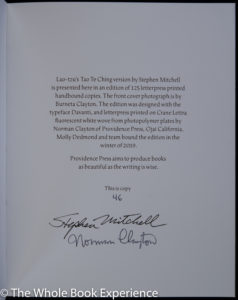 AVAILABILITY: Printed in an edition of 125, copies of the edition are still available from Classic Letterpress
AVAILABILITY: Printed in an edition of 125, copies of the edition are still available from Classic Letterpress
FORTHCOMING: Next up for Providence Press is an edition of the Heart Sutra, again in Stephen Mitchell’s translation. Check the presses website in upcoming months for information and I’ll try to keep you posted.
WISHLIST: Given the Providence Press’ mission to “produce books as beautiful as the writing is wise,” I’d love to see some texts that have never (to my knowledge) received the fine press treatment. Two that come to mind are the Yoga Sutra of Patañjali and the anonymous Cloud of Unknowing.

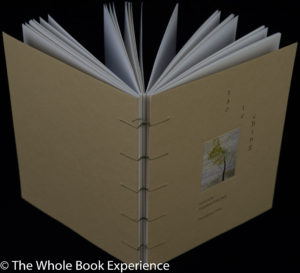
I found the Providence Press printing of the Tao at Codex where I had scouted some 200+ booths seeking spiritual texts being newly printed by a private press. I found one: this one. I bought a copy and then three more as gifts for friends who love fine printing and binding on spiritual texts but who find the Christian/Jewish texts overly abundant (another Song of Songs or Ecclesiastes seems redundant however lovely). I am delighted to know that Norman and the Providence Press will go ahead with Stephen Mitchell’s new version of the “Heart Sutra” in a strikingly beautiful and unusual format paying homage to the first printed book, the The Hyakumantō darani or ‘One Million Pagoda Dharani’, the oldest extant examples of printing in Japan and one of the earliest in the world. The eighth century Japanese chronicle the Shoku Nihongi records that they were printed between 764 and 770 on the orders of Empress Shōtoku as an act of atonement and reconciliation. 1256 years later that seems curiously appropriate. I can’t wait!